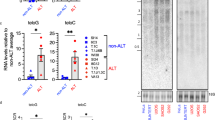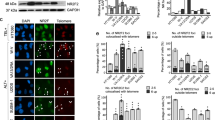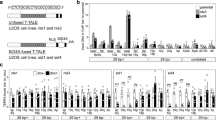Abstract
Extrachromosomal telomere repeat (ECTR) DNA is unique to cancer cells that maintain telomeres through the alternative lengthening of telomeres (ALT) pathway, but the role of ECTRs in ALT development remains elusive. We found that induction of ECTRs in normal human fibroblasts activated the cGAS-STING-TBK1-IRF3 signaling axis to trigger IFNβ production and a type I interferon response, resulting in cell-proliferation defects. In contrast, ALT cancer cells are commonly defective in sensing cytosolic DNA. We found that STING expression was inhibited in ALT cancer cell lines and transformed ALT cells. Notably, the ALT suppressors histone H3.3 and the ATRX–Daxx histone chaperone complex were also required to activate the DNA-sensing pathway. Collectively, our data suggest that the loss of the cGAS-STING pathway may be required to evade ECTR-induced anti-proliferation effects and permit ALT development, and this requirement may be exploited for treatments specific to cancers utilizing the ALT pathway.
This is a preview of subscription content, access via your institution
Access options
Access Nature and 54 other Nature Portfolio journals
Get Nature+, our best-value online-access subscription
$29.99 / 30 days
cancel any time
Subscribe to this journal
Receive 12 print issues and online access
$189.00 per year
only $15.75 per issue
Buy this article
- Purchase on Springer Link
- Instant access to full article PDF
Prices may be subject to local taxes which are calculated during checkout






Similar content being viewed by others
Accession codes
References
Woo, S.R., Corrales, L. & Gajewski, T.F. The STING pathway and the T cell-inflamed tumor microenvironment. Trends Immunol. 36, 250–256 (2015).
Barber, G.N. STING: infection, inflammation and cancer. Nat. Rev. Immunol. 15, 760–770 (2015).
Ishikawa, H. & Barber, G.N. STING is an endoplasmic reticulum adaptor that facilitates innate immune signalling. Nature 455, 674–678 (2008).
Ishikawa, H., Ma, Z. & Barber, G.N. STING regulates intracellular DNA-mediated, type I interferon-dependent innate immunity. Nature 461, 788–792 (2009).
Liu, S. et al. Phosphorylation of innate immune adaptor proteins MAVS, STING, and TRIF induces IRF3 activation. Science 347, aaa2630 (2015).
Sun, L., Wu, J., Du, F., Chen, X. & Chen, Z.J. Cyclic GMP-AMP synthase is a cytosolic DNA sensor that activates the type I interferon pathway. Science 339, 786–791 (2013).
Ahn, J., Konno, H. & Barber, G.N. Diverse roles of STING-dependent signaling on the development of cancer. Oncogene 34, 5302–5308 (2015).
Ohkuri, T. et al. STING contributes to antiglioma immunity via triggering type I IFN signals in the tumor microenvironment. Cancer Immunol. Res. 2, 1199–1208 (2014).
Xia, T., Konno, H., Ahn, J. & Barber, G.N. Deregulation of STING signaling in colorectal carcinoma constrains DNA damage responses and correlates with tumorigenesis. Cell Rep. 14, 282–297 (2016).
Woo, S.R. et al. STING-dependent cytosolic DNA sensing mediates innate immune recognition of immunogenic tumors. Immunity 41, 830–842 (2014).
Klarquist, J. et al. STING-mediated DNA sensing promotes antitumor and autoimmune responses to dying cells. J. Immunol. 193, 6124–6134 (2014).
Bryan, T.M., Englezou, A., Dalla-Pozza, L., Dunham, M.A. & Reddel, R.R. Evidence for an alternative mechanism for maintaining telomere length in human tumors and tumor-derived cell lines. Nat. Med. 3, 1271–1274 (1997).
Kim, N.W. et al. Specific association of human telomerase activity with immortal cells and cancer. Science 266, 2011–2015 (1994).
Henson, J.D. et al. DNA C-circles are specific and quantifiable markers of alternative-lengthening-of-telomeres activity. Nat. Biotechnol. 27, 1181–1185 (2009).
Pickett, H.A. & Reddel, R.R. Molecular mechanisms of activity and derepression of alternative lengthening of telomeres. Nat. Struct. Mol. Biol. 22, 875–880 (2015).
Dilley, R.L. & Greenberg, R.A. ALTernative telomere maintenance and cancer. Trends Cancer 1, 145–156 (2015).
Groff-Vindman, C., Cesare, A.J., Natarajan, S., Griffith, J.D. & McEachern, M.J. Recombination at long mutant telomeres produces tiny single- and double-stranded telomeric circles. Mol. Cell. Biol. 25, 4406–4412 (2005).
Cesare, A.J. & Griffith, J.D. Telomeric DNA in ALT cells is characterized by free telomeric circles and heterogeneous t-loops. Mol. Cell. Biol. 24, 9948–9957 (2004).
Compton, S.A., Choi, J.H., Cesare, A.J., Ozgür, S. & Griffith, J.D. Xrcc3 and Nbs1 are required for the production of extrachromosomal telomeric circles in human alternative lengthening of telomere cells. Cancer Res. 67, 1513–1519 (2007).
Wang, R.C., Smogorzewska, A. & de Lange, T. Homologous recombination generates T-loop-sized deletions at human telomeres. Cell 119, 355–368 (2004).
Lin, C.Y. et al. Extrachromosomal telomeric circles contribute to Rad52-, Rad50- and polymerase delta-mediated telomere-telomere recombination in Saccharomyces cerevisiae. Eukaryot. Cell 4, 327–336 (2005).
Natarajan, S. & McEachern, M.J. Recombinational telomere elongation promoted by DNA circles. Mol. Cell. Biol. 22, 4512–4521 (2002).
Zellinger, B., Akimcheva, S., Puizina, J., Schirato, M. & Riha, K. Ku suppresses formation of telomeric circles and alternative telomere lengthening in Arabidopsis. Mol. Cell 27, 163–169 (2007).
Vannier, J.B., Pavicic-Kaltenbrunner, V., Petalcorin, M.I., Ding, H. & Boulton, S.J. RTEL1 dismantles T loops and counteracts telomeric G4-DNA to maintain telomere integrity. Cell 149, 795–806 (2012).
Broz, P. & Monack, D.M. Newly described pattern recognition receptors team up against intracellular pathogens. Nat. Rev. Immunol. 13, 551–565 (2013).
Barber, G.N. Innate immune DNA-sensing pathways: STING, AIMII and the regulation of interferon production and inflammatory responses. Curr. Opin. Immunol. 23, 10–20 (2011).
van Steensel, B., Smogorzewska, A. & de Lange, T. TRF2 protects human telomeres from end-to-end fusions. Cell 92, 401–413 (1998).
Li, B., Jog, S.P., Reddy, S. & Comai, L. WRN controls formation of extrachromosomal telomeric circles and is required for TRF2DeltaB-mediated telomere shortening. Mol. Cell. Biol. 28, 1892–1904 (2008).
Moiseeva, O., Mallette, F.A., Mukhopadhyay, U.K., Moores, A. & Ferbeyre, G. DNA damage signaling and p53-dependent senescence after prolonged beta-interferon stimulation. Mol. Biol. Cell 17, 1583–1592 (2006).
Lovejoy, C.A. et al. Loss of ATRX, genome instability, and an altered DNA damage response are hallmarks of the alternative lengthening of telomeres pathway. PLoS Genet. 8, e1002772 (2012).
Lewis, P.W., Elsaesser, S.J., Noh, K.M., Stadler, S.C. & Allis, C.D. Daxx is an H3.3-specific histone chaperone and cooperates with ATRX in replication-independent chromatin assembly at telomeres. Proc. Natl. Acad. Sci. USA 107, 14075–14080 (2010).
Schwartzentruber, J. et al. Driver mutations in histone H3.3 and chromatin remodeling genes in pediatric glioblastoma. Nature 482, 226–231 (2012).
Heaphy, C.M. et al. Altered telomeres in tumors with ATRX and DAXX mutations. Science 333, 425 (2011).
Jiao, Y. et al. DAXX/ATRX, MEN1, and mTOR pathway genes are frequently altered in pancreatic neuroendocrine tumors. Science 331, 1199–1203 (2011).
Scherer, M. & Stamminger, T. Emerging role of PML nuclear bodies in innate immune signaling. J. Virol. 90, 5850–5854 (2016).
Law, M.J. et al. ATR-X syndrome protein targets tandem repeats and influences allele-specific expression in a size-dependent manner. Cell 143, 367–378 (2010).
Wong, L.H. et al. ATRX interacts with H3.3 in maintaining telomere structural integrity in pluripotent embryonic stem cells. Genome Res. 20, 351–360 (2010).
Eid, R. et al. Genetic inactivation of ATRX leads to a decrease in the amount of telomeric cohesin and level of telomere transcription in human glioma cells. Mol. Cell. Biol. 35, 2818–2830 (2015).
Tchkonia, T., Zhu, Y., van Deursen, J., Campisi, J. & Kirkland, J.L. Cellular senescence and the senescent secretory phenotype: therapeutic opportunities. J. Clin. Invest. 123, 966–972 (2013).
Freund, A., Orjalo, A.V., Desprez, P.Y. & Campisi, J. Inflammatory networks during cellular senescence: causes and consequences. Trends Mol. Med. 16, 238–246 (2010).
Zitvogel, L., Galluzzi, L., Kepp, O., Smyth, M.J. & Kroemer, G. Type I interferons in anticancer immunity. Nat. Rev. Immunol. 15, 405–414 (2015).
Gajewski, T.F. & Corrales, L. New perspectives on type I IFNs in cancer. Cytokine Growth Factor Rev. 26, 175–178 (2015).
Woo, S.R., Corrales, L. & Gajewski, T.F. Innate immune recognition of cancer. Annu. Rev. Immunol. 33, 445–474 (2015).
Clynes, D. et al. Suppression of the alternative lengthening of telomere pathway by the chromatin remodeling factor ATRX. Nat. Commun. 6, 7538 (2015).
Napier, C.E. et al. ATRX represses alternative lengthening of telomeres. Oncotarget 6, 16543–16558 (2015).
Bower, K. et al. Loss of wild-type ATRX expression in somatic cell hybrids segregates with activation of Alternative Lengthening of Telomeres. PLoS One 7, e50062 (2012).
Acknowledgements
We thank R.R. Reddel (Children's Medical Research Institute) for providing cell line samples; M.-C. Yao, R.-H.Chen, M.-Z. Lai, C. Wen and J. Lingner for discussions; H.-C. S. Yen for the cGAS construct; T.E. Chen for technical help; and the Genomics Core, Bioinformatics-Biology Core and Imaging Core in the Institute of Molecular Biology at Academia Sinica for help with data collection and analysis. Research in the laboratory of L.-Y. Chen was supported by Career Development Award CDA-105-L01 from Academia Sinica and grants from the Ministry of Science and Technology (105-2311-B-001-055-MY3).
Author information
Authors and Affiliations
Contributions
Y.-A.C. and L.-Y.C. designed the study. Y.-A.C. performed most of the experiments, with assistance from Y.-L.S., H.-Y.H. and Y.-P.T. Y.A.C., T.-L.S. and L.-Y.C. wrote the manuscript.
Corresponding author
Ethics declarations
Competing interests
The authors declare no competing financial interests.
Integrated supplementary information
Supplementary Figure 1 Analyses of ECTRs by C-circle and T-circle assays.
(a) C-circle and (b) T-circle amplification reactions using genomic DNA from different cell lines in the presence (+) or absence (-) of phi29 DNA polymerase. Using 32P-labeled telomeric probes, C-circle reaction products and 50ng of denatured genomic DNA (input) were analyzed by dot blots, and T-circle reaction products were detected by in-gel hybridization. Asterisks denote ALT cell lines.
Supplementary Figure 2 ECTRs in U2OS cells do not induce IFNβ expression.
(a-b) Dot blots analysis of extrachromosomal DNA (ecDNA) in U2OS cells prepared by fractionation using 32P-labeled telomeric and Alu probes. Quantifications of radioisotope signals were shown in b. Singles of native (Nat.) and denatured (Den.) samples indicate single-stranded DNA and total DNA, respectively. (c) Immunofluorescence staining with anti-cGAS antibody (green) coupled with Tel-FISH (red) in U2OS cells expressing flag-cGASm2A. Nuclei were visualized by DAPI staining (blue). Enlarged images show co-localization between cytoplasmic ECTRs and cGAS. Scale bar, 10 μm. Quantifications of ECTR positive cells (≥ 2 cytoplasmic telomeric foci) and co-localization between ECTRs and cGAS are shown (right). The ECTR positive cells with and without co-localization between cytoplasmic ECTRs and cGAS are indicated as +cGAS and -cGAS, respectively. The n values indicate the numbers of cells analyzed. (d) T-circle assay of U2OS/Vector and U2OS/ERT2-TRF2∆B cells. The cells treated with or without 4-OHT for 48 h were subjected to genomic DNA extraction and subsequent T-circle amplification reactions using phi29 DNA polymerase. Linear telomere restriction fragments (TRFs) and phi29-dependent amplification products of TCs were detected by in-gel hybridization using 32P-labeled telomeric probes. (e) Real-time RT-PCR analysis of IFNβ mRNA in U2OS/Vector and U2OS/ERT2-TRF2∆B cells treated with 4-OHT for 48 h. U2OS/Vector cells transfected with poly(I:C) served as a positive control. (mean ± s.d.; n=3 technical replicates of representatives of three independent experiments) n.s., not significant, ***P≤0.001, paired t-test.
Supplementary Figure 3 Analysis of IFNβ expression in BJTL cells expressing ERT2-TRF2 and ERT2-TRF2ΔB.
(a) Western blots and (b) immunofluorescence staining using anti-myc antibody in BJTL cells stably expressing vector, myc-ERT2-TRF2 or myc-ERT2-TRF2ΔB and treated with 4-OHT for the indicated times. Telomeric foci and nuclei were visualized following Tel-FISH and DAPI staining, respectively. Scale bar, 10 μm. Arrows in b indicate representative telomeric localization of myc-ERT2-TRF2 and ERT2-TRF2ΔB. (c) Analysis of IFNβ-mRNA by real-time RT-PCR in the cells in a treated with 4-OHT for 48 h. (d-f) Comparison between transient and prolong 4-OHT treatments in BJTL/ERT2-TRF2ΔB cells. Schematic of experimental design of 4-OHT treatments was shown in d. Tel-FISH (red) and DAPI staining (blue) of 4-OHT-untreated (-) and -treated (+) BJTL/ERT2-TRF2ΔB cells were shown in e. Scale bar, 10 μm. Arrows indicate cytoplasmic telomeric foci. IFNβ-mRNA levels were analyzed by real-time RT-PCR (f).
Supplementary Figure 4 ECTRs induce expression of IFNβ and ISGs and affect cell proliferation in cGAS and STING dependent manner.
(a) Real-time RT-PCR analysis of mRNA levels of indicated genes in BJTL/ERT2-TRF2ΔB cells treated with/without 4-OHT for 48 h. Error bars indicate +/- s.e.m. of triplicate technical replicates and are representative of three independent experiments (n.s., not significant, *P≤0.05, **P≤0.01, paired t-test). (b) ELISA analyses of secreted IFNβ and CXCL10 from BJTL/ERT2-TRF2ΔB cells transfected with control (siCtrl: non-target) or cGAS siRNAs for 48 h, followed by 4-OHT treatments for 96 h. Error bars indicate +/- s.e.m. of triplicate technical replicates and are representative of three independent experiments (n.d., not detectable, *P≤0.05, **P≤0.01, unpaired t-test). (c-d) Western blot analyses of BJTL/ERT2-TRF2ΔB cells transfected with control (siCtrl: non-target), cGAS or STING siRNAs for 48 h using antibodies against cGAS, STING and GAPDH. (e-f) Real-time RT-PCR analysis of IFNβ mRNA in BJTL/ERT2-TRF2∆B cells transfected with control (siCtrl: non-target), cGAS or STING siRNAs for 48 h, followed by 4-OHT treatment for 48 h. (g-h) Cell growth analyses of BJTL/ERT2-TRF2ΔB cells transfected with indicated siRNAs for 48 h followed by 4-OHT treatment for 36 h. Cell numbers were analyzed at day 4 after 4-OHT addition. Relative growth rate indicates the cell number ratio of +4-OHT to -4-OHT samples. (mean ± s.d.; n=3 technical replicates of representatives of three independent experiments) n.s., not significant, *P≤0.05, **P≤0.01, ***P≤0.01, paired t-test.
Supplementary Figure 5 Silencing cGAS and p53 rescue cell proliferation.
(a) Western blot analyses of BJTL/ERT2-TRF2ΔB cells transfected with control (siCtrl: non-target), cGAS or p53 (TP53) siRNAs for 48 h using antibodies against cGAS, TP53, p21 and GAPDH. p21 expression is transcriptionally regulated by p53, so depletion of p53 reduces p21 protein levels. (b) Cell growth analyses of BJTL/ERT2-TRF2ΔB cells transfected with siRNAs for 48 h, followed by 4-OHT treatment for 36 h. Cell numbers were analyzed at day 4 after 4-OHT addition. Relative growth rate indicates the cell number ratio of +4-OHT to -4-OHT samples. (mean ± s.d.; n=3 independent experiments) n.s., not significant, **P≤0.01, ***P≤0.001, paired t-test.
Supplementary Figure 6 Functional and expression analyses of STING in ALT cell lines.
(a) Functional assay of STING using cGAMP. Cells were permeabilized with digitonin and treated with cGAMP (100 nM) for 4 h, followed by real-time RT-PCR analyses of IFNβ mRNA. (b) Relative STING mRNA levels of BJTL and in vitro-transformed ALT cell lines. (mean ± s.d.; n=3 technical replicates of representatives of three independent experiments)
Supplementary information
Supplementary Text and Figures
Supplementary Figures 1–6 and Supplementary Data Set (PDF 6945 kb)
Rights and permissions
About this article
Cite this article
Chen, YA., Shen, YL., Hsia, HY. et al. Extrachromosomal telomere repeat DNA is linked to ALT development via cGAS-STING DNA sensing pathway. Nat Struct Mol Biol 24, 1124–1131 (2017). https://doi.org/10.1038/nsmb.3498
Received:
Accepted:
Published:
Issue Date:
DOI: https://doi.org/10.1038/nsmb.3498
This article is cited by
-
Interplay between ATRX and IDH1 mutations governs innate immune responses in diffuse gliomas
Nature Communications (2024)
-
The complementarity of DDR, nucleic acids and anti-tumour immunity
Nature (2023)
-
A non-genetic switch triggers alternative telomere lengthening and cellular immortalization in ATRX deficient cells
Nature Communications (2023)
-
Targeting telomeres: advances in telomere maintenance mechanism-specific cancer therapies
Nature Reviews Cancer (2022)
-
The cGAS–STING pathway and cancer
Nature Cancer (2022)



